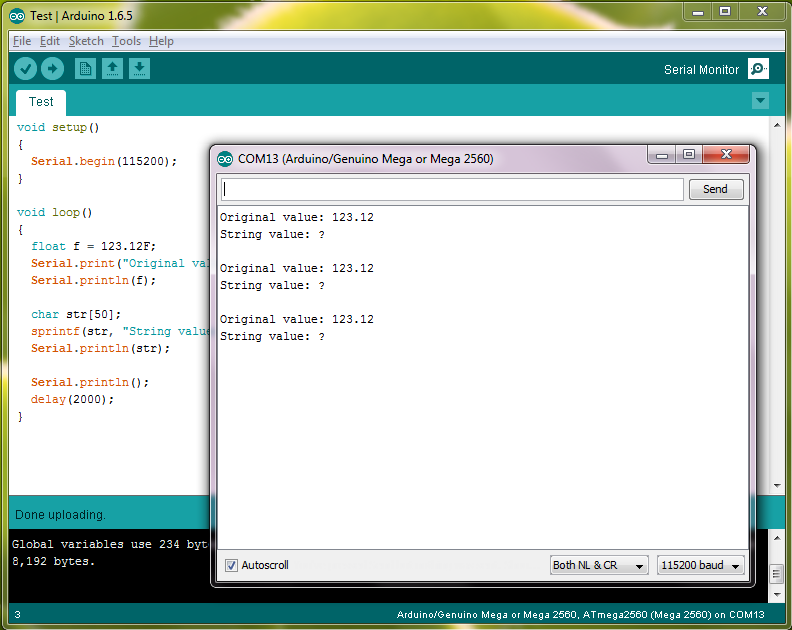-
Arduino Serial Write Float카테고리 없음 2020. 3. 16. 14:12
In AVR, there is a write(int) overloaded method, that match exactly with write(0), so the compiler doesn't complain. On the other side, 101 for example has only a write(uint8t) method, so the compiler doesn't know if he should use that, or write(const char.), because both require a type conversion.I am not so sure it is a good idea to hide the fact that write takes only raw bytes by overloading it in the AVR libraries, but i guess that it was done to keep people from complaining about the ambiguous overload;-). Or just do in SAM what is done in AVR and add the write(int) et al methods to HardwareSerial.h.Then you have to do it in SoftwareSerial also (and other Print derived classes, if any), for consistency.It could be in Print, but then i guess that the compiler won't honour the inline (to be checked), and that we don't want another overhead on such a low level function.BTW, a workaround to this particular problem is to do Serial.write(byte(0)) (which is also more elegant IMO).That's of course the simplest solution, then the write overloads should be suppressed from HardwareSerial for consistency. Or just do in SAM what is done in AVR and add the write(int) et al methods to HardwareSerial.h.Then you have to do it in SoftwareSerial also (and other Print derived classes, if any), for consistency.It could be in Print, but then i guess that the compiler won't inline the function (to be checked), and that we don't want another overhead on such a low level function.BTW, a workaround to this particular problem is to do Serial.write(byte(0)) (which is also more elegant IMO).That's of course the simplest solution, then the write overloads should be suppressed from HardwareSerial for consistency.
I am trying to send a floating point number from a python script to an Arduino. I am not sure how to do this, especially in a pythonic way.A little bit of research brought me to this very similar question:I vaguely understand why this would work for an int but don't know how to modify it.1) In this question it makes sense to convert to a char, send, and then convert back to a int by casting on the Arduino, I can't think how to do that for a float.2) Why do they convert to a Char anyway?3) What code do I run on the arduino to get this back into a float?4) Can I use bitwise operators on floating point numbers?I'm new to python and also to low level programming. I am also aware that python and low level don't mix to well.
I am using Linux but ideally I need a cross platform solution. Although I would prefer to get it working then worry about cross platform later.
In this question it makes sense to convert to a char, send, and then convert back to a int by casting on the Arduino, I can't think how to do that for a float.Instead of using a format specifier of B for an unsigned byte, use f for a single-precision float. AVR-GCC doesn't support double-precision floats, so don't bother with d.Why do they convert to a Char anyway?You don't. You convert it to bytes (hence the b prefix on the representation of the value) so that the byte-oriented serial protocol can transmit it.

On Python 2.x str is already bytes, so no prefix is required there.What code do I run on the arduino to get this back into a float?Use Serial.readBytes to dump the bytes from the serial connection into a float variable. Float f.if (Serial.readBytes((char.)&f, sizeof(f))!= sizeof(f)).Can I use bitwise operators on floating point numbers? Because they may not necessarily remain valid floating point numbers afterwards. Floating point numbers are (should) be stored in.If you simply write the binary bytes of a floating point number down the serial line, it should be possible to unpack them at the other end.To do this (Arduino C/C), make a pointer from your variable, by casting the address of it to char. Void.
would probably work too. Float myvalue = 22.812;myport.write((const char.)&myvalue, sizeof(float)/.4./);And the unpacking - there's a few ways to do this, but I like: float incomingvalue;unsigned char buffer4;// If we read enough bytes, unpacked itif (myserial.readBytes(buffer, sizeof(float)) sizeof(float))memcpy(&incomingvalue, buffer, sizeof(float));else// I/O error - no data, not enough bytes, etc.incomingvalue = 0On the other end (python), bytes are best handled with the struct module. This will handle the packing and unpacking for you. Import struct.try:ieee754data = myserial.read(4)myfloat = struct.unpack('f', ieee754data)catch:# I/O Error, or junk datamyfloat = 0.0And packing: ieee754data = struct.pack('f', myfloat)try:myserial.write(ieee754data)catch:pass #TODO - I/O ErrorOne more note - You might consider using doubles instead of floats for extra precision.
Sending Serial Data To Arduino
Python floats have the precision of a C/C double already.